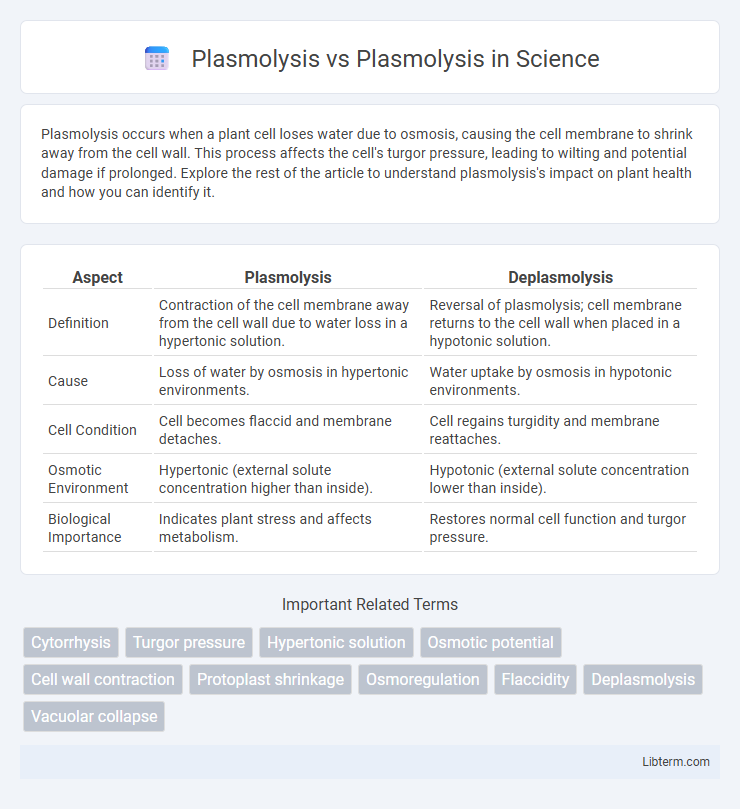Plasmolysis occurs when a plant cell loses water due to osmosis, causing the cell membrane to shrink away from the cell wall. This process affects the cell's turgor pressure, leading to wilting and potential damage if prolonged. Explore the rest of the article to understand plasmolysis's impact on plant health and how you can identify it.
Table of Comparison
| Aspect | Plasmolysis | Deplasmolysis |
|---|---|---|
| Definition | Contraction of the cell membrane away from the cell wall due to water loss in a hypertonic solution. | Reversal of plasmolysis; cell membrane returns to the cell wall when placed in a hypotonic solution. |
| Cause | Loss of water by osmosis in hypertonic environments. | Water uptake by osmosis in hypotonic environments. |
| Cell Condition | Cell becomes flaccid and membrane detaches. | Cell regains turgidity and membrane reattaches. |
| Osmotic Environment | Hypertonic (external solute concentration higher than inside). | Hypotonic (external solute concentration lower than inside). |
| Biological Importance | Indicates plant stress and affects metabolism. | Restores normal cell function and turgor pressure. |
Introduction to Plasmolysis
Plasmolysis occurs when plant cells lose water through osmosis, causing the cell membrane to shrink away from the cell wall due to hypertonic environments. This process is crucial for understanding cellular responses to osmotic stress and the physical changes within plant cells during water loss. Plasmolysis serves as a fundamental concept in plant physiology, demonstrating the impact of solute concentration differences on protoplasmic movement.
Understanding the Concept of Plasmolysis
Plasmolysis is the process in which plant cells lose water in a hypertonic solution, causing the cell membrane to pull away from the cell wall, leading to cell shrinkage. This phenomenon occurs when osmosis drives water out of the cell, resulting in a decrease in turgor pressure essential for maintaining cell rigidity and function. Understanding plasmolysis is crucial for studying plant cell responses to environmental stress, such as salt or drought conditions, and its impact on cellular metabolism and plant health.
Types of Plasmolysis
Plasmolysis occurs in plant cells when water leaves the cell, causing the cell membrane to detach from the cell wall. There are two primary types: incipient plasmolysis, where the plasma membrane begins to pull away from the cell wall but the cell maintains turgor pressure, and evident plasmolysis, characterized by a significant gap between the cell membrane and cell wall as the cell shrinks further. Understanding these types helps in studying osmotic stress and water potential in plant physiology.
Mechanism of Plasmolysis
Plasmolysis occurs when plant cells lose water through osmosis, causing the cell membrane to contract away from the cell wall due to a hypertonic external solution. The mechanism involves water moving out of the cytoplasm into the surrounding medium, resulting in decreased turgor pressure and cytoplasmic shrinkage. This process is critical in studying cell membrane permeability and plant cell response to osmotic stress.
Causes and Triggers of Plasmolysis
Plasmolysis occurs when plant cells lose water due to exposure to hypertonic solutions, causing the cell membrane to detach from the cell wall. Key triggers include high salt concentration, drought stress, and excessive uptake of solutes, which create osmotic imbalance. This process disrupts cellular functions, leading to reduced turgor pressure and wilting in plants.
Observable Effects of Plasmolysis
Plasmolysis occurs when plant cells lose water in a hypertonic solution, causing the cell membrane to detach from the cell wall and the cytoplasm to shrink visibly. The observable effects include the formation of gaps between the cell wall and membrane, and the chloroplasts appearing concentrated in the center of the cell. This visible shrinkage highlights the loss of turgor pressure, crucial for maintaining plant cell rigidity.
Biological Importance of Plasmolysis
Plasmolysis occurs when plant cells lose water in a hypertonic solution, causing the cell membrane to detach from the cell wall, which serves as a critical indicator of cell water potential and osmotic balance. This process is biologically important because it helps researchers understand cellular responses to water stress, vital for studying plant drought tolerance and salt stress resistance. Measuring plasmolysis also aids in assessing the integrity of cell membranes and the impact of environmental toxins on plant cells.
Plasmolysis in Plant Cells
Plasmolysis in plant cells occurs when water exits the cell due to a hypertonic environment, causing the cell membrane to detach from the cell wall as the cytoplasm shrinks. This process is critical for studying osmoregulation and cell membrane integrity in plants under stress conditions, such as high salinity or drought. Observing plasmolysis under a microscope provides key insights into the semi-permeable nature of plant cell membranes and the impact of external solute concentrations on cellular homeostasis.
Experimental Observation of Plasmolysis
Experimental observation of plasmolysis involves placing plant cells, such as onion epidermal cells, in a hypertonic solution causing water to exit the cell, leading to the plasma membrane pulling away from the cell wall. This process can be visualized under a microscope as cell shrinkage and formation of gaps between the cell wall and membrane. Measurements of the extent of plasmolysis across different solute concentrations provide quantitative data on osmotic pressure and cell membrane permeability.
Conclusion: Significance of Plasmolysis in Biology
Plasmolysis is crucial in biology as it demonstrates the effect of osmotic pressure on plant cells, highlighting the importance of water balance for cellular integrity. This process helps in understanding cell membrane permeability and the interaction between cells and their environment, essential for studies in plant physiology and pathology. Insights from plasmolysis experiments guide agricultural practices and improve our knowledge of plant responses to environmental stress.
Plasmolysis Infographic

 libterm.com
libterm.com